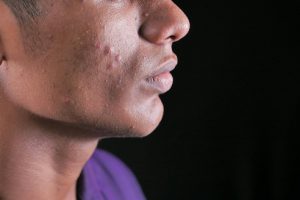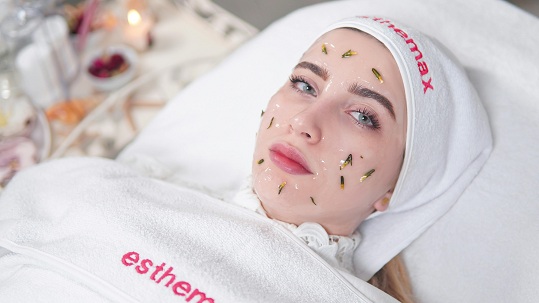
Dry skin, while often associated with flakiness and irritation, can also be a breeding ground for pesky pimples, especially on the cheeks.
Dealing with acne on dry skin requires a delicate balance of moisturizing and targeted treatment to prevent further irritation and maintain skin health. In this article, we’ll delve into the causes of dry skin pimples on cheeks and explore effective remedies and routines to combat them.
Understanding the Dynamics: Dry Skin and Pimples
Pimples on dry skin, particularly on the cheeks, can be a result of various factors. One common culprit is the lack of moisture, leading to the overproduction of sebum to compensate for the dryness. This excess oil, along with dead skin cells, can clog pores and result in acne formation.
Furthermore, harsh weather conditions, such as cold temperatures and low humidity, prevalent during winter, can exacerbate dryness and trigger breakouts.
Additionally, using skincare products that strip the skin of its natural oils can disrupt the skin barrier, making it more susceptible to acne.
How to Remove Acne from Dry Skin: Effective Strategies
-
Hydrate, Hydrate, Hydrate:
The cornerstone of managing dry skin pimples is hydration. Opt for a gentle, non-comedogenic moisturizer that replenishes lost moisture without clogging pores. Look for ingredients like hyaluronic acid, glycerin, and ceramides to lock in hydration and strengthen the skin barrier.
-
Home Remedies for Acne on Dry Skin:
Natural remedies can be a gentle yet effective way to treat dry skin pimples. Consider using ingredients like honey, aloe vera, tea tree oil, and oatmeal to soothe inflammation, reduce redness, and control acne-causing bacteria.
-
Tailored Skincare Routine:
A skincare routine specifically designed for dry, acne-prone skin can work wonders. Opt for a mild, fragrance-free face wash that cleanses without stripping natural oils. Follow up with a hydrating toner to balance pH levels and prep the skin for subsequent treatments.
-
Targeted Treatments:
Incorporate acne-fighting ingredients like salicylic acid or benzoyl peroxide into your skincare routine. However, be mindful of potential drying effects and adjust usage accordingly. Consider spot treating pimples with a gentle, yet effective acne treatment to avoid further irritation.
-
Moisturize Strategically:
Choose a moisturizer formulated for acne-prone skin that provides adequate hydration without clogging pores. Look for lightweight, oil-free formulas that contain ingredients like niacinamide or hyaluronic acid to soothe dryness and regulate sebum production.
-
Protective Measures:
Shield your skin from harsh environmental factors by wearing a broad-spectrum sunscreen with at least SPF 30 daily. This helps prevent further damage and inflammation, especially during winter months when UV exposure remains significant.
Differentiating Dry Skin Acne from Oily Skin Acne
Dry skin acne, characterized by smaller, inflamed pimples, is often accompanied by flakiness and tightness due to insufficient moisture. These pimples may appear more irritated and red, reflecting the skin’s compromised barrier function.
In contrast, oily skin acne presents as larger comedonal lesions, such as blackheads and whiteheads, particularly in the T-zone, where sebum production is higher.
The excess oil on the skin’s surface creates an environment conducive to the formation of these lesions.
Understanding these distinctions is crucial for selecting appropriate skincare products and treatments tailored to each skin type’s specific needs, optimizing efficacy and minimizing potential irritation or exacerbation of acne symptoms.
Can Dry Skin Cause Pimples?
Dry skin’s role in pimple formation stems from a complex interplay of factors. Insufficient moisture prompts the skin to overproduce sebum, an oily substance intended to lubricate and protect.
However, this excess sebum can mix with dead skin cells, obstructing pores and fostering the growth of acne-causing bacteria. Moreover, dryness compromises the skin’s natural barrier function, weakening its defenses against external aggressors like pollutants and microbes.
This vulnerability amplifies inflammation and encourages the proliferation of acne. Thus, while dry skin may not directly cause pimples, its impact on sebum production and skin barrier integrity significantly contributes to their development.
It underscores the importance of maintaining optimal skin hydration and barrier function to mitigate acne risk and promote overall skin health.
Winter Woes: Treating Dry Acne-Prone Skin in the Cold Months
During the winter months, individuals with dry, acne-prone skin face unique challenges exacerbated by the cold, dry air. This environment can significantly deplete the skin’s moisture levels, exacerbating dryness, sensitivity, and acne breakouts.
The lack of humidity in the air exacerbates these issues, as the skin struggles to retain moisture, resulting in increased transepidermal water loss (TEWL) and compromised skin barrier function.
To counteract these effects, it’s crucial to prioritize hydration and nourishment for the skin. Opting for rich, emollient moisturizers is key, as they provide a protective barrier that seals in moisture and helps restore the skin’s lipid barrier.
Look for moisturizers containing ingredients like ceramides, glycerin, and hyaluronic acid, which attract and retain moisture within the skin.
In addition to moisturizing, incorporating occlusive agents such as petroleum jelly or lanolin can provide an extra layer of protection against moisture loss.
These heavy-duty moisturizers act as a sealant, preventing water from evaporating from the skin’s surface and maintaining hydration levels throughout the day.
Indoor heating further exacerbates dryness, as it further depletes the air of moisture. To counteract this, consider using a humidifier in your home to reintroduce moisture into the air.
This helps create a more conducive environment for the skin, reducing the likelihood of excessive dryness and irritation.
Moreover, practicing good skincare habits is essential during the winter months. Opt for gentle, fragrance-free cleansers that effectively remove impurities without stripping the skin of its natural oils.
Avoid hot showers, as they can further dehydrate the skin, opting instead for lukewarm water and limiting shower time.
Finally, don’t forget the importance of sun protection, even during the winter months. UV rays can still penetrate through clouds and windows, contributing to skin damage and exacerbating acne-related inflammation.
Apply a broad-spectrum sunscreen with at least SPF 30 daily, focusing on areas prone to breakouts and sun exposure.
By incorporating these strategies into your skincare routine, you can effectively manage dry, acne-prone skin during the harsh winter months, maintaining a healthy, radiant complexion year-round.
Best pimples treatment for face
Conclusion
Managing dry skin pimples on cheeks requires a comprehensive approach that addresses hydration, targeted treatment, and protective measures.
By adopting a tailored skincare routine and incorporating effective remedies, you can effectively combat acne while maintaining a healthy, radiant complexion, even during the harshest of winters.
Remember to consult a dermatologist if your acne persists or worsens despite home care efforts, as they can provide personalized recommendations and treatments tailored to your skin’s needs.
Further Reading:
How to get rid of dry skin on the face: Top 6 remedies
Dry Skin and Acne: Causes and Treatments
FAQs:
How do you get rid of dry skin on your face from pimples?
To address dry skin from pimples on your face, start by hydrating with a gentle, non-comedogenic moisturizer. Use targeted treatments like salicylic acid or benzoyl peroxide to treat acne while avoiding further dryness. Incorporate hydrating ingredients like hyaluronic acid or glycerin into your skincare routine. Avoid harsh cleansers and opt for a gentle face wash suitable for dry, acne-prone skin. Protect your skin from harsh weather with a broad-spectrum sunscreen and consider using a humidifier indoors. Lastly, consult a dermatologist for personalized advice if dryness persists despite home care efforts.
�What is a dry skin with small pimples?
Dry skin with small pimples, often termed as “papulopustular acne,” is characterized by the presence of inflamed, red bumps or pustules on the skin’s surface. These pimples typically occur in areas where the skin is dry and prone to irritation, such as the cheeks. They may result from a combination of factors, including dehydration, impaired skin barrier function, and excess sebum production. Proper hydration, gentle skincare, and targeted acne treatments are essential for managing this condition and restoring skin health.
�How do I stop pimples on my cheeks?
To prevent pimples on your cheeks, maintain a consistent skincare routine tailored to your skin type, focusing on gentle cleansing and moisturizing. Avoid touching your face frequently to prevent the transfer of bacteria and irritants. Incorporate acne-fighting ingredients like salicylic acid or benzoyl peroxide into your routine. Keep your hair clean and away from your face, as oils and products can contribute to breakouts. Consider dietary adjustments and stay hydrated to support overall skin health. Lastly, consult a dermatologist for personalized advice and treatment options if pimples persist.
�Why am I getting acne bumps on my cheeks?
Acne bumps on the cheeks can be due to various factors such as excess oil production, clogged pores, bacterial buildup, hormonal fluctuations, and skin irritation. Poor skincare habits, stress, diet, and genetics can also contribute to their development. Identifying the underlying cause and adopting a targeted skincare routine can help alleviate and prevent further breakouts. Consulting a dermatologist for personalized advice is advisable for persistent or severe acne.



